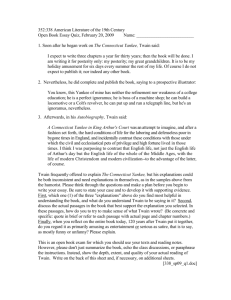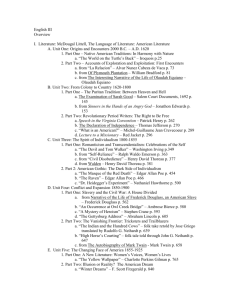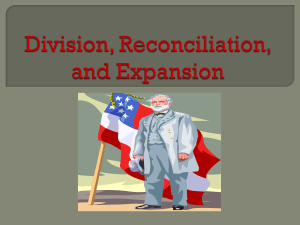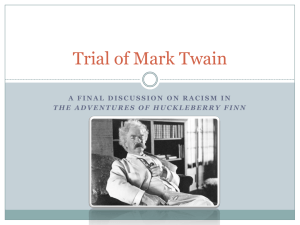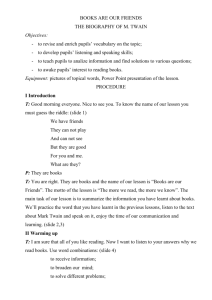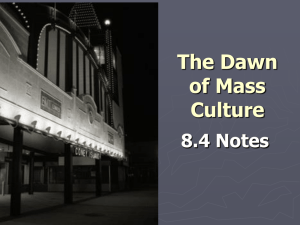A Toast to the Oldest Inhabitant
advertisement
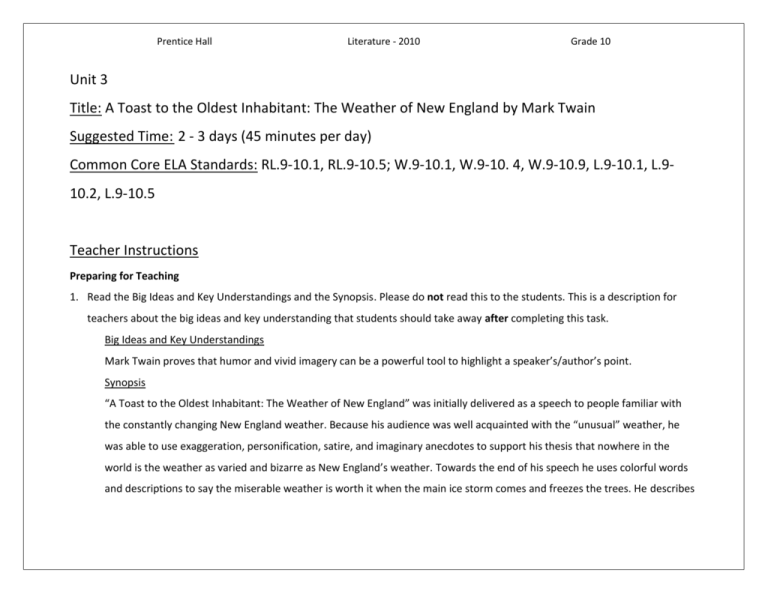
Prentice Hall Literature - 2010 Grade 10 Unit 3 Title: A Toast to the Oldest Inhabitant: The Weather of New England by Mark Twain Suggested Time: 2 - 3 days (45 minutes per day) Common Core ELA Standards: RL.9-10.1, RL.9-10.5; W.9-10.1, W.9-10. 4, W.9-10.9, L.9-10.1, L.910.2, L.9-10.5 Teacher Instructions Preparing for Teaching 1. Read the Big Ideas and Key Understandings and the Synopsis. Please do not read this to the students. This is a description for teachers about the big ideas and key understanding that students should take away after completing this task. Big Ideas and Key Understandings Mark Twain proves that humor and vivid imagery can be a powerful tool to highlight a speaker’s/author’s point. Synopsis “A Toast to the Oldest Inhabitant: The Weather of New England” was initially delivered as a speech to people familiar with the constantly changing New England weather. Because his audience was well acquainted with the “unusual” weather, he was able to use exaggeration, personification, satire, and imaginary anecdotes to support his thesis that nowhere in the world is the weather as varied and bizarre as New England’s weather. Towards the end of his speech he uses colorful words and descriptions to say the miserable weather is worth it when the main ice storm comes and freezes the trees. He describes Prentice Hall Literature - 2010 Grade 10 the light hitting the ice and creating beautiful colors. He completes his speech forgiving the weather for its atrocities and thanking it for offering people culminating beauty. 2. Ensure students know the meaning of hyperbole and satire. 3. Read the entire selection, keeping in mind the Big Ideas and Key Understandings. 4. Re-read the text while noting the stopping points for the Text Dependent Questions and teaching Tier II/academic vocabulary. During Teaching 1. Students read the entire selection independently. 2. Teacher reads the text aloud while students follow along or students take turns reading aloud to each other. Depending on the text length and student need, the teacher may choose to read the full text or a passage aloud. For a particularly complex text, the teacher may choose to reverse the order of steps 1 and 2. 3. Students and teacher re-read the text while stopping to respond to and discuss the questions, continually returning to the text. A variety of methods can be used to structure the reading and discussion (i.e., whole class discussion, think-pair-share, independent written response, group work, etc.) Text Dependent Questions Text-dependent Questions In the first paragraph, Twain implies that the raw apprentices in the weather clerk’s factory are sent to New England to learn about how to make the weather. What humorous image do you get from his description of the apprentices? Provide evidence. A hyperbole is an obvious and intentional exaggeration and Evidence-based Answers Our Maker makes everything in New England but the weather. Apprentices experiment in New England and are then promoted to make weather elsewhere in the world. This is humorous because people do not “make” weather, and it implies that the weather is so varied because the new apprentices are always practicing creating the weather. Mark Twain exaggerates the types of weather as evidenced Prentice Hall Literature - 2010 Grade 10 figure of speech not intended to be taken literally. In the first paragraph on page 477 beginning with the sentence “There is a sumptuous variety about the New England weather…” what hyperbole does Twain use here to make his point about New England weather? How is this statement a hyperbole? when he says, “In the spring, I have counted one hundred and thirty-six different kinds of weather inside of four and twenty hours.” The exaggeration is the number of times he claims the weather changes in one day. In the first paragraph Twain discusses a man that had a marvelous collection of weather on exhibit at the Centennial. Explain how Twain’s offer of a one-day stay in New England to collect weather samples is an exaggeration. Rather than travel the world the man at the Centennial was able to collect hundreds of kinds of weather, some he’d never heard of before, in only four days. After discarding blemished weather, the man still had weather left over to spare, hire out, sell, deposit, invest, and give to the poor. These are exaggerations of the number of weather changes possible in a four-day time span. The exaggerated reaction of the native New Englanders toward the visiting poets is that they kill the poets for glorifying “Beautiful Spring.” The image of the locals killing poets is a much more powerful image than one of simply describing people who are upset with visitors. Spring is a time of rebirth and renewal. Many people feel renewed energy in the spring after a harsh, cold winter. For these reasons, “Beautiful Spring” is a common topic for poets. State the exaggerated reaction of the native New Englanders toward the visiting poets. How is Twain’s exaggerated description more powerful? On pages 478 - 479, Old Probabilities, the old term for the weather forecaster, appears to exude one image when he forecasts for other parts of the country. Twain offers a different exaggerated image when he attempts to forecast the New England weather. Contrast the two images using specific hyperbolic evidence from the text. Why is exaggeration effective in this example? “…..crisply and confidently…checks off what today’s weather is going to be …” “…sail along in the joy and pride of his power…” (other parts of the country) “…till he gets to New England, and then --- see his tail drop.” The former image of weatherman shows one of a man confident of his predictions; however, once he tries to forecast New England weather, he becomes unnerved and appears incompetent. Because most people see weathermen as confident and competent in their forecasts, the exaggeration Prentice Hall Literature - 2010 Grade 10 Twain provides offers us a humorous visual image of an uncollected forecaster. What example of humor in the text does Twain use to describe the confidence of the weather forecaster? (pages 478-479) “He can’t anymore tell than he can tell how many Presidents of the United States there’s going to be next year.” By referring to the famously disputed presidential election of 1876 (the prior year) where two men were declared winners until a final winner was named, Twain demonstrates great exaggeration of the incompetence of the weather forecaster relative to New England’s weather. On page 479, Twain uses much exaggeration in the paragraph Twain says people get ready for a drought and go out only to beginning “Yes, one of the brightest gems…” Use the text to get drowned and then prepare for an earthquake only to get explain the exaggeration. Twain follows this exaggeration with struck by lightning. He is saying the weather is so extreme that an understatement. Identify the statement and explain why it is the opposite of what is expected can be expected to happen. an example of understatement. He uses understatement by saying, “These are great disappointments.” The events are huge and would be great calamities and he saying that they are simply disappointments makes his comment humorous. Read the sentence on page 479 beginning, “I could speak Weather is being compared to humans when Twain calls it volumes about the inhuman perversity….” Perversity in this “inhuman perversity.” Twain reminisces that because he loves text means twisted, cranky, and stubborn. Explain how the sound of rain on a tin roof, he covered a portion of his roof personifying the weather as cranky can be considered with tin. It is ironic that the one joy he can get from the rain is humorous. Explain the personification he uses and the irony denied him because the personified rain “skips” hitting the tin Twain creates in this anecdote about rain and a tin roof. covered section. This further exemplifies the humor in the selection. Irony can be described as the opposite of what is generally He describes experiences such as drowning and being struck by expected. How does Twain use understatement in the lightning as being “great disappointments.” paragraph beginning, “Yes, one of the brightest gems in the Preparing for a drought and subsequently drowning, and New England weather….” on page 479 to add humor to the preparing for an earthquake and then being struck by lightning selection? Find two examples of irony in this particular excerpt. are both examples of irony. Prentice Hall Literature - 2010 Grade 10 Satire is using wit, irony and sarcasm to expose human faults. In Twain implies that congressmen will steal anything of value. the same paragraph as the previous question, what does Twain “Lightning…when it strikes a thing, it doesn’t leave enough of satirically imply about congressmen? that thing behind for you to tell whether – well, you’d think it was something valuable, and a Congressman had been there.” In the second-to-last paragraph, Twain does not use any Twain gives the reader the impression that the residents are humor. Instead, he uses really descriptive words to show how accepting of the weather variances because the payoff is in the ice storm can be viewed. What image and impression about witnessing the splendor of the frozen trees, “ice that is as the ice storm does Twain create? How do his previous bright and clear as crystal when every bough and twig is strung comments about New England’s weather contrast with the with ice beads, frozen dew drops, and the whole tree sparkles description of the ice storm? cold and white.” He also says that the sun shining on the frozen dew drops creates brilliant jewels. The contrast is that he spent the first portion of his speech describing the weather using examples such as “136 different kinds of weather in four and twenty hours” and the weather was so erratic that weathermen could not make accurate forecasts. The latter part of his speech is spent glorifying the weather for its beauty. How does the lack of humor in this paragraph impact the The lack of humor shows his serious passion regarding the reader’s understanding of Twain’s true feelings regarding New results of the terrible weather. By using powerful words England’s weather? instead of humor, “the tree becomes a spraying fountain, the very explosion of dazzling jewels. It stands there the acme, the climax, the supremest possibility in art or nature, of bewildering, intoxicating, intolerable magnificence. One cannot make the words too strong.” By being serious instead of humorous Twain changes the tone of the piece so we can see his true passionate feelings about the weather and his forgiveness of its changeability. Find the sentence beginning “Then the wind waves the In Twain’s description of ice beads and frozen dewdrops, he branches….” on page 480. Myriad means a great number. How states that the sun turns the myriad of beads and dewdrops to does Twain use the term myriad to help him enhance his prisms, thereby capturing the color and beauty of thousands of description of the ice storm’s beauty? drops of melting ice. Prentice Hall Literature - 2010 Contrast the last paragraph of the selection with the rest of the essay. Where in the text does Mark Twain describe his true feelings of New England weather? How does his lack of humor in this paragraph wrap up the essay? Grade 10 Throughout the essay Twain talks ABOUT the weather and portrays it as harsh, ugly, and unpredictable. However, in the last paragraph he speaks TO the weather and praises its beauty. Twain’s feelings can be found in the last paragraph of his speech. Up to this point, he describes the weather as harsh, ugly, and unpredictable, but ultimately glorifies the weather because of the resulting ice storm. The conversation he has with the weather is different because previously he was speaking ABOUT the weather, and now he is speaking TO the weather forgiving it and loving it by saying, “You are the most enchanting weather in the world!” His lack of humor and his direct conversation to the weather allows the reader to understand that humor was used to better describe how crazy and harsh the weather is, but how beautiful the ending results can be. Prentice Hall Literature - 2010 Grade 10 Meaning needs to be provided Meaning can be learned from context Tier II/Academic Vocabulary These words require less time to learn These words require more time to learn (They are concrete or describe an object/event/ process/characteristic that is familiar to students) (They are abstract, have multiple meanings, are a part of a word family, or are likely to appear again in future texts) Page 477 – apprentices Page 478 – prophecy Page 479 - procession Page 480 – clime Page 480 – compensates Page 480 - acme Page 478 – forbearing Page 480 – plume Page 480 – inconceivable Page 480 – foibles Page 476 - reverently Page 479 – disproportioned Page 479 – volumes Page 479 – inhuman perversity Page 480 – myriads Prentice Hall Literature - 2010 Grade 10 Culminating Writing Task Prompt Mark Twain used humor through vivid imagery, hyperbole, satire, personification and irony in this text as a way to 1) highlight the intensity of New England’s weather and 2) demonstrate how the felt about New England’s weather. Using specific instances from the text, make a claim regarding how Twain used these literary devices to accomplish these two feats. Compose an essay that is one page in length. Support your claims with valid reasoning and relevant and sufficient evidence from the text, including direct quotes, and page numbers. Teacher Instructions 1. Students identify their writing task from the prompt provided. 2. Students complete an evidence chart as a pre-writing activity. Teachers should guide students in gathering and using any relevant notes they compiled while reading and answering the text-dependent questions earlier. Some students will need a good deal of help gathering this evidence, especially when this process is new and/or the text is challenging! Evidence Page Quote or paraphrase number “The weather is always doing something there; always attending strictly to business; always getting up new designs and trying the out on 477 people to see how they will go. But it gets through more business in spring than in any other season.” “Yes, one of the brightest gems in the New England weather is the dazzling uncertainty of it. 479 Elaboration / explanation of how this evidence supports ideas or argument Twain personifies the weather by comparing it to a person doing business, creating new ideas and trying them out on people. The imagery is similar to that of a designer creating something new and testing it on a focus group. This sets us up to understanding that Twain acknowledges the weather is expressive and has a mind of its own. Using satire, Twain describes the weather as being so uncertain that people prepare for one event, Prentice Hall Literature - 2010 There is only one thing certain about it, you are certain there is going to be plenty of weather-a perfect grand review; but you never can tell which end of the procession is going to move first.” “Now, as to the size of the weather in New England – lengthways, I mean. It is utterly disproportionate to the size of that little country. Half the time, when it is packed as full as it can stick, you will see that New England weather sticking out beyond the edges and projecting hundreds and hundreds of miles over neighboring states.” Twains further describes the state as a she and says she cannot hold all of the weather and says you can see “cracks” where “she” has strained to hold it all in. 479 "Month after month I lay up my hate and grudge against the New England weather..." Twain tells the weather he forgives it and hopes there are no hard feelings for all his negativity towards it. 480 Grade 10 but an opposing weather event occurs. For example, residents prepare for a drought and leave the umbrella home only to get drowned when they go about their day. His use of satire makes the vivid descriptions funny to the reader, yet one can understand the veracity of the weather in New England. Twain personifies New England as a she and describes her as so full from the weather that she just can’t hold it all in, so spills over into neighboring states. This hyperbole gives the reader the image of a small woman being bombarded and filled up with different weather patterns. His exaggeration creates a vivid picture for the reader. The irony is that he hates the weather as much as he loves it as evidenced by his vivid lamentations throughout the essay and his forgiveness at the end and how he does not hold it responsible and glorifies it as the most enchanting in the world 3. Once students have completed the evidence chart, they should look back at the writing prompt in order to remind themselves what kind of response they are writing (i.e. expository, analytical, argumentative) and think about the evidence they found. (Depending on the grade level, teachers may want to review students’ evidence charts in some way Prentice Hall Literature - 2010 Grade 10 to ensure accuracy.) From here, students should develop a specific thesis statement. This could be done independently, with a partner, small group, or the entire class. Consider directing students to the following sites to learn more about thesis statements: http://owl.english.purdue.edu/owl/resource/545/01/ OR http://www.indiana.edu/~wts/pamphlets/ thesis_statement.shtml. 4. Students compose a rough draft. With regard to grade level and student ability, teachers should decide how much scaffolding they will provide during this process (i.e. modeling, showing example pieces, and sharing work as students go). 5. Students complete final draft. Sample Answer In “A Toast to the Oldest Inhabitant: The Weather of New England” Mark Twain appears to have a love/hate relationship with the weather of New England. Twain personifies the weather by comparing it to a person doing business creating new ideas and trying these ideas out on people. On page 477 Twain quips, “The weather is always doing something there; always attending strictly to business; always getting up new designs and trying them out on people to see how they will go. But it gets through more business in spring than in any other season.” The imagery presented here is that of a designer creating something new and using a focus group to test out the product or idea. This allows the reader to begin to understand Twain’s acknowledgment that the weather has a mind of its own and is expressive. The humor can be found in the sheer image of a person quickly moving around creating one thing, trying it out on someone, changing it and quickly trying it out, and so on, thereby getting out 136 different designs within 24 hours. The exaggeration makes it clear that there are not really 136 different weather patterns, but that the weather changes so quickly it can feel overwhelming. Prentice Hall Literature - 2010 Grade 10 Using irony, Twain describes the weather as being so uncertain that residents prepare for one event, but an opposing weather event occurs. For example, on page 479 he says, “Yes, one of the brightest gems in the New England weather is the dazzling uncertainty of it. There is only one thing certain about it, you are certain there is going to be plenty of weather-a perfect grand review; but you never can tell which end of the procession is going to move first.” Residents prepare for a drought and leave the umbrella home only to get drowned when they go about their day. His use of irony makes the vivid descriptions funny to the reader, yet one can understand the veracity of the weather in New England and understand how extreme the weather changes are in New England compared to the rest of the world. This use of exaggeration makes the reader laugh, but in many regions the reader may also be able to relate to the extreme weather changes. By comparing New England to a woman on page 479, “Now, as to the size of the weather in New England – lengthways, I mean. It is utterly disproportionate to the size of that little country. Half the time, when it is packed as full as it can stick, you will see that New England weather sticking out beyond the edges and projecting hundreds and hundreds of miles over neighboring states.” Twains describes the state as a she and says she cannot hold all of the weather and says you can see “cracks” where “she” has strained to hold it all in. The reader is further able to visualize a small woman being filled to bursting with the "weather." He describes the amount of weather as being so much that she can't hold it all in, so it spills over into neighboring states. His exaggeration creates a vivid picture for the reader. Now the reader can see how much weather the state experiences and to what extreme. Reading the essay, one may get the feeling that Twain truly hates the weather in New England. He throws the reader for a loop when he describes the ice storm as beautiful and worth the pain of the weather changes. He says on page 480, "Month after month I lay up my hate and grudge against the New England weather...", but then the irony comes in when he describes his feelings after the ice storm at last saying, "I forgive you..." Based on his immediate forgiveness, the reader comes to understand that while Prentice Hall Literature - 2010 Grade 10 the extreme weather is taking place Twain hates it, but as soon as that ice storm hits and leaves its beauty, he forgets his previous assertions of hate and forgives the weather. Mark Twain’s use of various figures of speech in his speech “A Toast to the Oldest Inhabitant: The Weather of New England” add not only to the humor of the story, but present the reader with such clear images that upon completion of the story, the reader must get up and put on his own coat to brace himself against a phantom chill wind. Additional Tasks Twain writes about the extreme weather in New England using humor, satire, personification, and vivid imagery. Write a description in Twain’s style using his same writing tools (humor, satire, personification, and vivid imagery) to describe the weather in your area. Answer: Students should write about extreme weather unique to their area such as tornadoes, hurricanes, earthquakes, floods, blizzards, etc. The writing should include humor, satire, personification, and vivid imagery. Examples for a paragraph about hurricanes: o thunder – schools of mighty fish arriving in a tidal wave pounding on the roof o wind – the arguing and hissing of old people with crackly voices o rain – the oceans rising up and dumping their contents on an area o location – eye of the hurricane throwing a dart at a map to decide on location for landfall Prentice Hall Literature - 2010 Grade 10 Prentice Hall Literature - 2010 Name ______________________________________________ Grade 10 Date _________________ “A Toast to the Oldest Inhabitant: The Weather of New England” 1. In the first paragraph, Twain implies that the raw apprentices in the weather clerk’s factory are sent to New England to learn about how to make the weather. What humorous image do you get from his description of the apprentices? Provide evidence. 2. A hyperbole is an obvious and intentional exaggeration and figure of speech not intended to be taken literally. In the first paragraph on page 477 beginning with the sentence “There is a sumptuous variety about the New England weather…” what hyperbole does Twain use here to make his point about New England weather? How is this statement a hyperbole? 3. In the first paragraph Twain discusses a man that had a marvelous collection of weather on exhibit at the Centennial. Explain how Twain’s offer of a one-day stay in New England to collect weather samples is an exaggeration. 4. Spring is a time of rebirth and renewal. Many people feel renewed energy in the spring after a harsh, cold winter. For these reasons, “Beautiful Spring” is a common topic for poets. Prentice Hall Literature - 2010 Grade 10 State the exaggerated reaction of the native New Englanders toward the visiting poets. How is Twain’s exaggerated description more powerful? 5. On pages 478 - 479, Old Probabilities, the old term for the weather forecaster, appears to exude one image when he forecasts for other parts of the country. Twain offers a different exaggerated image when he attempts to forecast the New England weather. Contrast the two images using specific hyperbolic evidence from the text. Why is exaggeration effective in this example? 6. What example of humor in the text does Twain use to describe the confidence of the weather forecaster? (pages 478-479) 7. On page 479, Twain uses much exaggeration in the paragraph beginning “Yes, one of the brightest gems…” Use the text to explain the exaggeration. Twain follows this exaggeration with an understatement. Identify the statement and explain why it is an example of understatement. Prentice Hall Literature - 2010 Grade 10 8. Read the sentence on page 479 beginning, “I could speak volumes about the inhuman perversity….” Perversity in this text means twisted, cranky, and stubborn. Explain how personifying the weather as cranky can be considered humorous. Explain the personification he uses and the irony Twain creates in this anecdote about rain and a tin roof. 9. Irony can be described as the opposite of what is generally expected. How does Twain use understatement in the paragraph beginning, “Yes, one of the brightest gems in the New England weather….” on page 479 to add humor to the selection? Find two examples of irony in this particular excerpt. 10. Satire is using wit, irony and sarcasm to expose human faults. In the same paragraph as the previous question, what does Twain satirically imply about congressmen? 11. In the second-to-last paragraph, Twain does not use any humor. Instead, he uses really descriptive words to show how the ice storm can be viewed. What image and impression about the ice storm does Twain create? How do his previous comments about New England’s weather contrast with the description of the ice storm? Prentice Hall Literature - 2010 Grade 10 12. How does the lack of humor in this paragraph impact the reader’s understanding of Twain’s true feelings regarding New England’s weather? 13. Find the sentence beginning “Then the wind waves the branches….” on page 480. Myriad means a great number. How does Twain use the term myriad to help him enhance his description of the ice storm’s beauty? 14. Contrast the last paragraph of the selection with the rest of the essay. 15. Where in the text does Mark Twain describe his true feelings of New England weather? How does his lack of humor in this paragraph wrap up the essay?

